Johannes Fischer: McFarland recently published your book United States Women’s Chess Champions, 1937–2020, in which you portray the women who have won one or more U.S. Women’s Championships in that time. When and how did you get the idea for this book?
Alexey Root: I got the idea from my son William in November of 2020. I told him that I would like to write an eighth book and he suggested the topic of U.S. Women’s Champions.
Women’s chess in the U.S. is not as well documented as men’s chess. How did you conduct your research, especially for the U.S. Championships that were played a long time ago?
Chess magazines, such as American Chess Bulletin, Chess Life, and Chess Review, as well as newspaper chess columns, provided some games and information about players and championships. ChessBase also had games.
Chess historians and U.S. Women’s participants helped. The author of Bobby Fischer and His World, International Master (IM) John Donaldson, provided biographical information for some early champions and introduced me, via email, to John S. Hilbert. Hilbert was completing Albert W. Fox: A Chess Life On and Off the Board but took time away from that work to find women’s games and crosstables in 20th-century books and periodicals. IM Jack Peters emailed a Los Angeles Times database of women’s games from 1939-1965 and another database of his own games against women.
Woman International Master (WIM) Diane Savereide, a five-time U.S. Women’s Champion, and U.S. Women’s Championship participant WIM Dorothy "Dolly" Teasley shared their memories of two of the most accomplished women’s champions, seven-time champion WIM Mona May Karff and nine-time champion WIM Gisela Gresser. Their sharing was helpful, as I never met Karff and Gresser.
Karff’s first title was in 1938, her last title was in 1974, and her final appearance in the championship was in 1976. Gresser’s first title was in 1944, her last title was in 1969, and her final appearance in the championship was in 1979.
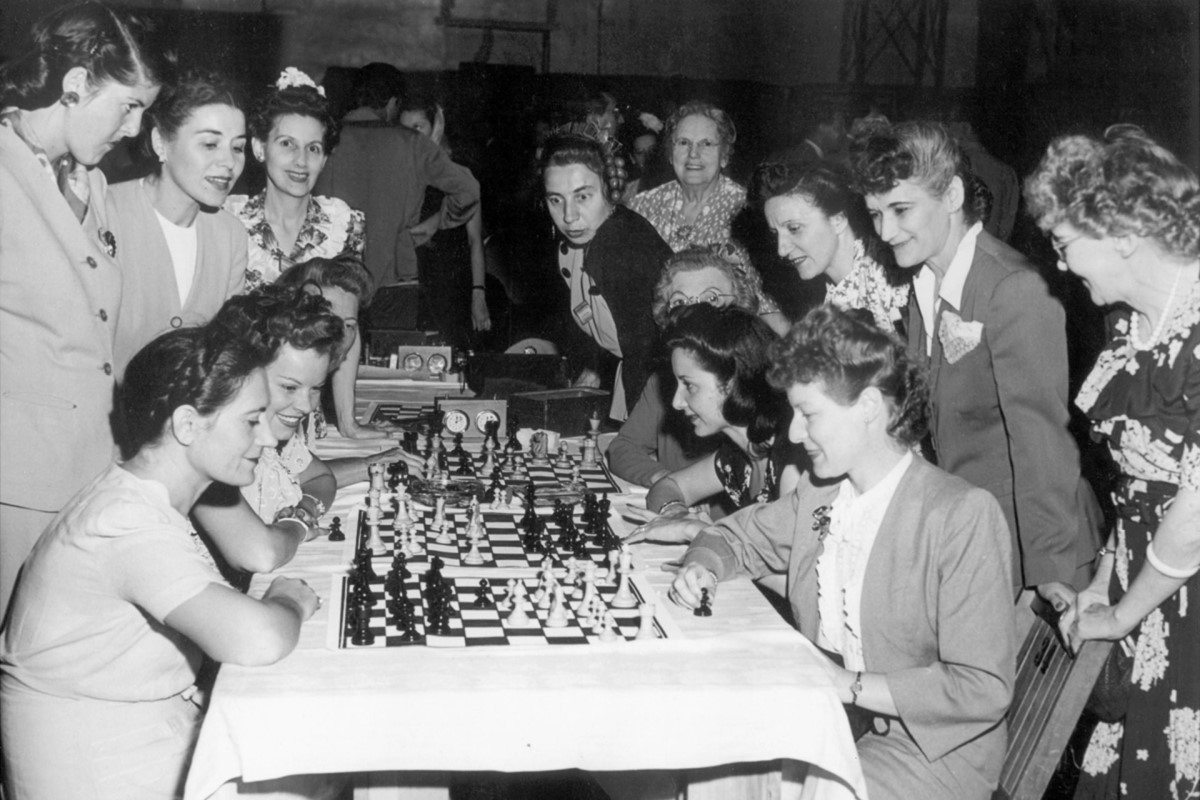
Mona May Karff playing White against Mary Bain at the 1956 Pan American Championship. | Photo: Nancy Roos / Collection of the World Chess Hall of Fame
To find some early games, and to check the notation provided by periodicals and databases, I visited the John G. White Collection of Chess and Checkers at the Cleveland Public Library.
As a chess teacher, chess writer and one of the best women players in the U.S. you were of course well acquainted with the most important aspects of the history of women’s chess in the U.S. But what surprised you the most when gathering material for the book?
When I was invited to the U.S. Women’s Championship for the first time, in 1981, the United States Chess Federation provided round trip airfare, food, lodging, and $50 in spending money. The total prize fund was $1,675.
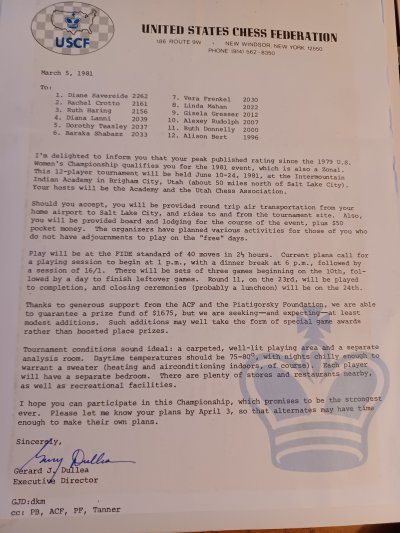
The invitational letter
What surprised me was learning that travel costs and prize money had not always been offered. For example, for the 1937 U.S. Women’s Championship, travel costs were not provided, and Adele Rivero’s first prize was an inscribed gold medal and retaining possession of the Hazel Allen trophy.
You played in ten U.S. Women’s Championships yourself and in 1989 you won the Championship. Do you still remember your first U.S. Women’s Championship, and do you still remember how it felt to win the title?
I played in my first U.S. Women’s Championship when I was 15 years old. Fellow first-time championship participant Baraka Shabazz was also 15. I was turning 16 a month after the tournament ended and Baraka’s 16th birthday was after mine. Baraka had been profiled in People magazine and other media outlets, as she was the first Black participant in the U.S. Women’s Championship.
Before the 1981 U.S. Women’s Championship, I was jealous of the media attention that Baraka had received. During the championship, when I saw the interactions between Baraka and her stepfather, I realized the tremendous pressure that Baraka was under. Then I felt sorry for Baraka rather than jealous of her. Dr. Daaim Shabazz (no relation to Baraka) has written about Baraka Shabazz for The Chess Drum.

Newspaper report about the U.S. Women's Championship 1981
In the 20th century, the U.S. Women’s Championship used to be held every two or three years. I played in the next two championships in 1984 and 1986. I was not invited to the 1987 championship, won 9-0 by Woman Grandmaster (WGM) Anna Akhsharumova.
The next time the championship was held was in 1989. As the other last-round games finished, I realized that a draw would be enough for clear first. I had a good position against Natasha Us, so she immediately accepted my draw offer. I felt relieved to become the 1989 U.S. Women’s Champion, scoring an undefeated 7 points out of 9 rounds. The stress of leading the championship was finally over!
.jpg)
Alexey Rudolph in 1989, Ruth Donnelly is in the background | Photo: Alexey Root
Are there any other highlights from the 10 championships that you played in that you still remember and that you would like to share?
Most championships had organized outings. Near the end of the 1990 U.S. Women’s Championship, we went to a Spartanburg Phillies minor league baseball game. During the early innings, WIM Sharon Burtman and I taught WIM Esther Epstein and Diana Gherghe how to sing "Take Me Out to the Ball Game." During the seventh-inning stretch, we were scheduled to sing from the announcers’ booth.
I had married IM Doug Root on August 6, 1989. One lyric from "Take Me Out to the Ball Game" is "root, root, root for the home team." Before we sang, I told the announcers that my last name was in the song three times. Then they announced us, mistakenly calling me by my maiden name Alexey Rudolph!
Apart from personal memories – what do you think is the significance of the U.S. Women’s Championship as a tournament – competitively and symbolically?
Without the U.S. Women’s Championships, women would be almost invisible in U.S. chess history. Gresser was the first U.S. woman to become a USCF-rated master, with a rating of 2211 in the April 1963 issue of Chess Life. But there were many men who were masters or higher by then. If ratings were how players earned chess media attention, Gresser might not have been noticed. She got attention because she won nine U.S. Women’s Championships. In the 21st century, U.S. Women’s Championships are still introducing top chess-playing women to the public.
In your book you present the biographies of 29 U.S. Women’s Champions – what struck you the most when researching and writing these biographies?
High entry fees and hotel room costs for opens, the most common tournament format in the U.S., are particularly challenging for some new immigrants. WGM Anjelina Belakovskaia’s first words in English were "two, five, and ten dollars per game" as she earned money against chess hustlers in Washington Square Park. WGM and IM Rusudan Goletiani worked as a babysitter and a housekeeper shortly after she arrived in the U.S.
About two thirds of the 29 champions that you portray in your book are immigrants to the U.S. Why do you think that is?
To continue with the players mentioned in my last response, Belakovskaia (Ukraine) and Goletiani (Georgia) were already WIMs before immigrating. Chess was a profession in the USSR. Generally, the women players from former Soviet countries had better training and results than U.S.-born players.
The women you portray come from all walks of life – you have millionaires like Mona May Karff or freewheeling artists like Lisa Lane or Sonja Graf – but it is striking how many of them made careers in other fields than chess after winning the title. Do you think this is an indicator of the educational value of chess?
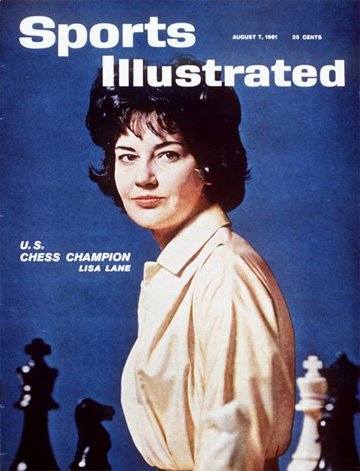
Lisa Lane on the cover of Sports Illustrated
It might be an indicator of the difficulty of making a living at chess. First prize for the 2022 U.S. Women’s Championship was enough money ($40,000) to live on for a year. But when I won the 1989 U.S. Women’s Championship, the first prize was $2,000 and that was a record-high first prize up to that point. By 1989, I had already been a high school teacher for two years. Public school teaching was how I supported myself, and my chess took a back seat to my work.
Despite their obvious differences and apart from their passion for chess – what do you think these 29 champions have in common?
We all played more games against men than against women. In the 20th century, girls and women were less than 5% of USCF membership and the U.S. Women’s Championship was held only once every two to three years. In the 21st century, girls and women are about 12% of US Chess membership and the U.S. Women’s Championship is held every year.
In both centuries, for most of their games, U.S. Women’s Champions competed against men. Maybe one thing we have in common is being a minority in chess, which we experience at almost every tournament except for the U.S. Women’s Championship.
I know it is a somewhat stupid question, so please forgive me for asking it anyway – but as it is such a hotly debated topic in other sports and in the history of the World Chess Champions I could not resist – who do you think is the GOAT, the greatest female American player of all time and why?
Gresser won the U.S. Women’s Championship nine times, and Grandmaster Irina Krush has won it eight times. I pick Krush as the GOAT because she is a grandmaster. Krush came close to winning her ninth title in 2022, losing to WGM Jennifer Yu in a playoff. Krush will participate in more U.S. Women’s Championships in the coming years and may yet get a ninth or even a tenth title. I am also voting for Krush as GOAT because she wrote an excellent foreword to United States Women’s Chess Champions, 1937–2020.

Irina Krush | Photo: Lennart Ootes
In your book you focus more on the individual players and their histories and less on the individual championships. Why did you choose this approach?
With players like Gresser and Krush (among others) winning multiple championships, it made sense to consolidate their championship years into long chapters. One-time champions, like me, have short chapters.
In the early years, each U.S. Women’s Championship was hosted by the Marshall Chess Club. Since 2009, the Saint Louis Chess Club has hosted the championships. With the same venues being used, 60 separate chapters—one for each championship—would get repetitive.
The book contains U.S. Women’s Championship games from every champion. Is there any game that you found particularly striking?
One striking game by Krush is her 1998 win over Jennifer Shahade. Shahade later became a WGM and won the U.S. Women’s Championship in 2002 and 2004.
Defeating Shahade was part of Krush winning the 1998 U.S. Women’s Championship with 8.5 out of 9, making her the youngest-ever champion at age 14.
Would you think it too vain to publish the game that you think is your personal best from the U.S. Women’s Championships?
Thanks for asking! I picked my win over WIM Liz Neely from the year I became U.S. Women’s Champion. The game header lists my last name as "Root" but it was still "Rudolph" at the time of this game.
Finally, to conclude: What was the biggest joy in writing your book and remembering the U.S. Women’s Champions?
My biggest joy was communicating with U.S. Women’s Champions. They were supportive and helpful, providing games, stories, and photos.
My next goal is to get each champion to autograph her chapter. That entails trips around the world, and I might not achieve the goal exactly. For example, Anna Akhsharumova and her husband Grandmaster Boris Gulko now live in Jerusalem. For SparkChess, I wrote about being in Jerusalem as the FIDE Press Officer for the FIDE World Team Championship 2022. Anna didn’t visit that championship, but Boris did. So, I had Boris sign the "Anna Akhsharumova" chapter.

In Jerusalem: (from left to right) Boris and Maya Gelfand, Boris Postovsky, Boris Gulko and Alexey Root | Photo: Alexey Root
Thank you for your time and the interview!
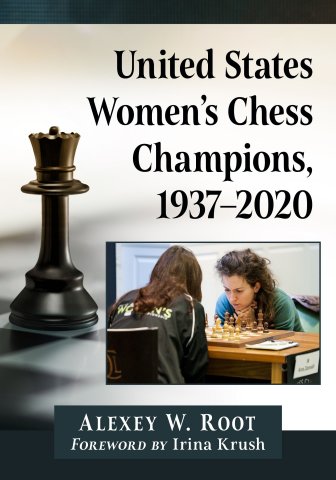
Alexey Root, United States Women's Chess Champions, 1937-2020, McFarland 2022, 240 pages
Links
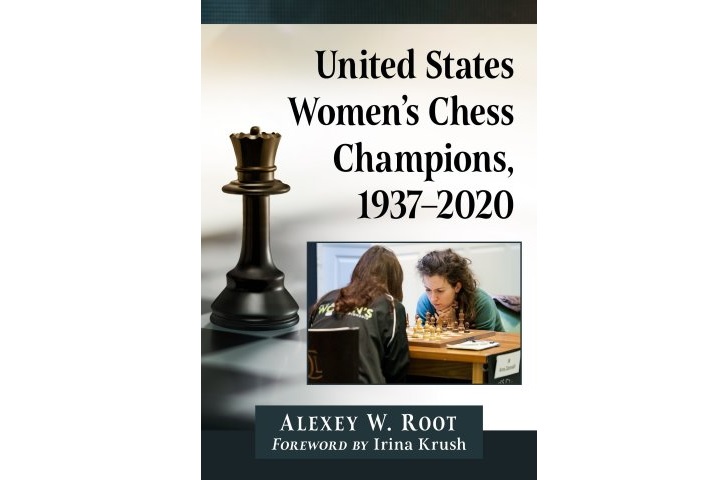




















.jpg)









